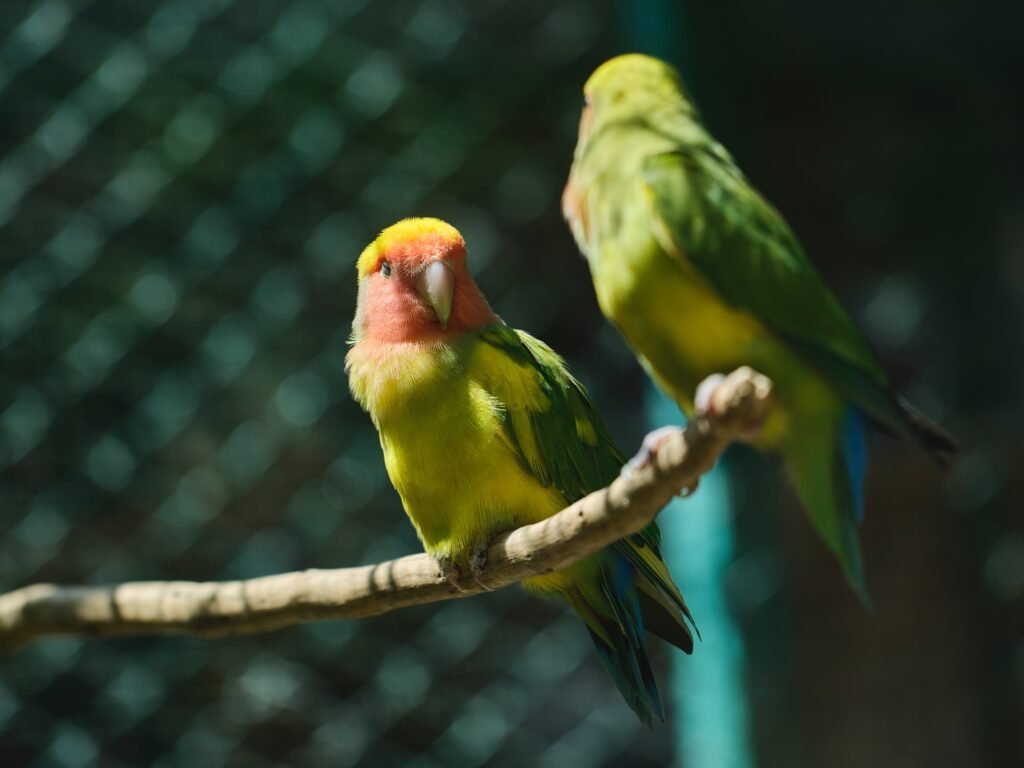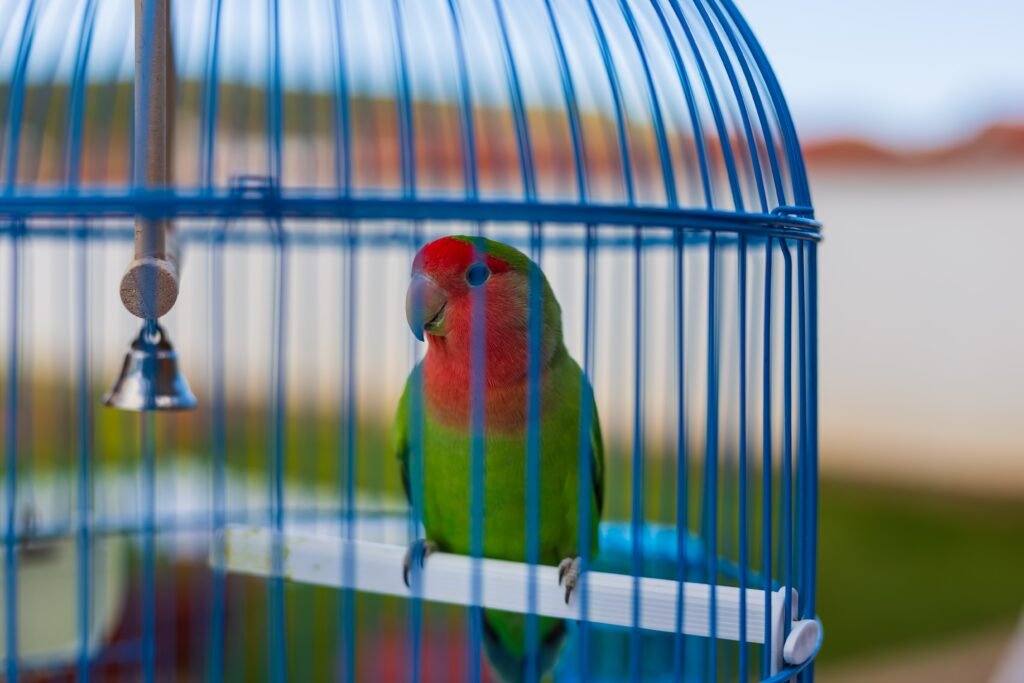Lovebirds are popular and enchanting birds known for their strong bonds and affectionate behaviour toward their partners. Their unique mating rituals and the journey of their eggs from nesting to hatching are fascinating to observe. In this article, we will delve into the intricate details of lovebird eggs, exploring their development, incubation, and the journey of the adorable hatchlings.
Nesting Behavior and Egg Laying
Lovebirds are meticulous nest builders, often choosing tree cavities or nesting boxes as their preferred locations. The female lovebird takes the lead in building the nest, using various materials such as twigs, leaves, feathers, and even soft bark. These materials are intricately woven to create a sturdy and cozy nest for the eggs.
Building a nest is a vital part of the lovebird’s reproductive process. Not only does it provide a safe and secure environment for the eggs, but it also symbolizes the love and commitment shared between the male and female lovebirds. The intricate weaving of materials ensures that the nest is strong enough to withstand the weight of the eggs and protect them from predators.
Once the nest is complete, the female will lay an average of 3 to 6 eggs, with an interval of approximately 2 days between each egg. Lovebird eggs are small, typically measuring around 0.8 to 1 inch in length. They have a smooth surface and come in various colours, ranging from pure white to pale blue or light yellow.
To ensure the eggs’ safety and warmth, the female lovebird carefully positions them within the nest, ensuring they are well-insulated and protected from external threats. This process showcases the lovebird’s instinctual knowledge of creating an optimal environment for their offspring.
Incubation Period
After the female lovebird lays the eggs, she and her partner take turns incubating them. The incubation period usually lasts around 23 to 25 days, during which the parents diligently keep the eggs warm and protected. This shared responsibility allows both partners to bond further and strengthen their relationship.
Incubation is a critical stage in the development of lovebird eggs. During this period, the embryos inside the eggs undergo significant growth and transformation. The parents’ constant warmth and attention provide an ideal temperature for the eggs to develop properly.
During incubation, the female lovebird spends most of her time on the eggs, while the male periodically takes over to give her a break. This alternating routine ensures that the eggs receive constant warmth and attention, which is crucial for their development. The exchange of incubation duties also allows the male to contribute actively to the nurturing process and build a stronger bond with his partner.
Development inside the Egg
Inside the lovebird egg, a remarkable transformation takes place. The embryo grows and develops, gradually becoming a tiny bird. As the days pass, the embryo becomes more recognizable, forming eyes, beaks, wings, and feathers.
Developing lovebird embryos inside the eggs is a complex and intricate process. It involves the growth and differentiation of various body parts and organs, including the skeletal, nervous, and digestive systems. The eggs provide a protective environment for this development, shielding the embryos from external harm and providing essential nutrients.
During this period, the eggs require a consistent temperature of around 98 to 100 degrees Fahrenheit (36 to 38 degrees Celsius) for proper development. The parents play a crucial role in maintaining this temperature by carefully regulating their body heat while incubating the eggs. Their instinctive ability to adjust their body temperature ensures that the embryos receive the optimal conditions for their growth and survival.
Hatching Process
After the incubation period, the moment arrives when the lovebird chicks are ready to break free from their shells. This process, known as hatching, is an exciting and eagerly anticipated event. The chicks use a small, specialized appendage on their beaks known as an egg tooth to crack open the shell.
Hatching is an incredible feat of strength and determination for the lovebird chicks. Inside the egg, they have been developing their muscles and bones in preparation for this moment. Using their egg tooth, they create a small hole in the shell, allowing them to breathe and taste the outside world.
The hatching process can take several hours. The chicks gradually chip away at the shell until they create a small hole through which they emerge into the world. This process requires patience and perseverance from the chicks as they use their energy and instinct to break free.
Once out of the shell, the chicks are covered in downy feathers and completely depend on their parents for warmth and nourishment. The parents immediately provide comfort and care to the newly hatched chicks, ensuring their safety and well-being.
Parental Care of the Hatchlings
After hatching, the lovebird parents continue caring for their newborn offspring. They ensure the chicks are kept warm, fed, and protected from potential threats. Both parents take turns feeding the hatchlings a regurgitated mixture of partially digested food, which provides them with essential nutrients for growth.
Parental care is crucial during the early stages of a lovebird’s life. The chicks rely entirely on their parents for sustenance and protection. The regurgitated food provides necessary nutrition and helps establish a strong bond between the parents and their offspring.
The lovebird parents are also responsible for removing any waste produced by the chicks and maintaining a clean and hygienic nest. They meticulously clean the nest, ensuring optimal conditions for the chicks’ growth and development. This level of care and dedication from both parents is crucial for the survival and healthy development of the hatchlings.
Growth and Independence
As the lovebird chicks grow, they go through various stages of development. Initially, they rely entirely on their parents for food and protection. However, as they mature, they gradually become more independent and explore their environment.
The growth and independence of lovebird chicks are remarkable to witness. They undergo physical and behavioural changes as they develop flight feathers and strengthen their wings. The parents encourage their exploration, allowing them to venture out of the nest and develop their flying abilities.
The chicks develop flight feathers within a few weeks and exercise their wings. They venture out of the nest, testing their flying abilities under the watchful eyes of their parents. This period of exploration and practice helps them develop the necessary skills to become self-sufficient birds. It is an essential part of their journey towards independence.
Conclusion
The journey of lovebird eggs from nesting to hatching is a captivating process showcasing these beautiful birds’ dedication and nurturing nature. From meticulously building nests to incubating the eggs and raising the hatchlings, lovebird parents ensure the survival and growth of their offspring.
Observing this journey provides a glimpse into the intricate world of avian reproduction, where love, care, and commitment play a vital role. Appreciating the remarkable journey from nesting to hatching allows us to understand the marvels of nature and the beauty of life’s beginnings. The love and devotion exhibited by lovebird parents towards their offspring is truly awe-inspiring, reminding us of the importance of family bonds and the miracle of life.
Lovebirds Eggs: The Journey from Nesting to Hatching – FAQ
- What materials do lovebirds use to build their nests?
- Lovebirds build their nests using various materials, such as twigs, leaves, feathers, and soft bark. These materials are intricately woven to create a sturdy and cozy nest for the eggs.
- How many eggs does a female lovebird typically lay?
- A female lovebird will lay an average of 3 to 6 eggs, with an interval of approximately 2 days between each egg.
- How long does the incubation period of lovebird eggs last?
- The incubation period of lovebird eggs usually lasts around 23 to 25 days. The male and female lovebirds take turns keeping the eggs warm and protected during this time.
- What is the hatching process like for lovebird chicks?
- The hatching process for lovebird chicks is an incredible feat of strength and determination. Using a specialized appendage called an egg tooth, the chicks create a small hole in the shell to emerge into the world. This process can take several hours, and once hatched, the chicks completely depend on their parents for warmth and nourishment.
.


